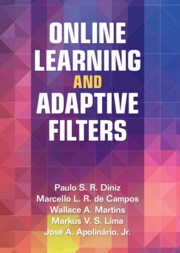5 - Adaptive Beamforming
Published online by Cambridge University Press: 24 November 2022
Summary
The chapter briefly introduces the main concepts of array signal processing, emphasizing those related to adaptive beamforming, and discusses how to impose linear constraints to adaptive filtering algorithms to achieve the beamforming effect. Adaptive beamforming, emphasizing the incoming signal impinging from a known direction by means of an adaptive filter, is the primary objective of the array signal processing addressed in this chapter. We start this study with the narrowband beamformer. The constrained LMS, RLS, conjugate gradient, and SMAP algorithms are introduced along with the generalized sidelobe canceller, and the Householder constrained structures; sparse promoting adaptive beamforming algorithms are also addressed in this chapter. In the following, it introduces the concepts of frequency-domain and time-domain broadband adaptive beamforming and shows their equivalence. The chapter wraps up with brief discussions and reference suggestions on essential topics related to adaptive beamforming, including the numerical robustness of adaptive beamforming algorithms.
Keywords
- Type
- Chapter
- Information
- Online Learning and Adaptive Filters , pp. 152 - 197Publisher: Cambridge University PressPrint publication year: 2022



